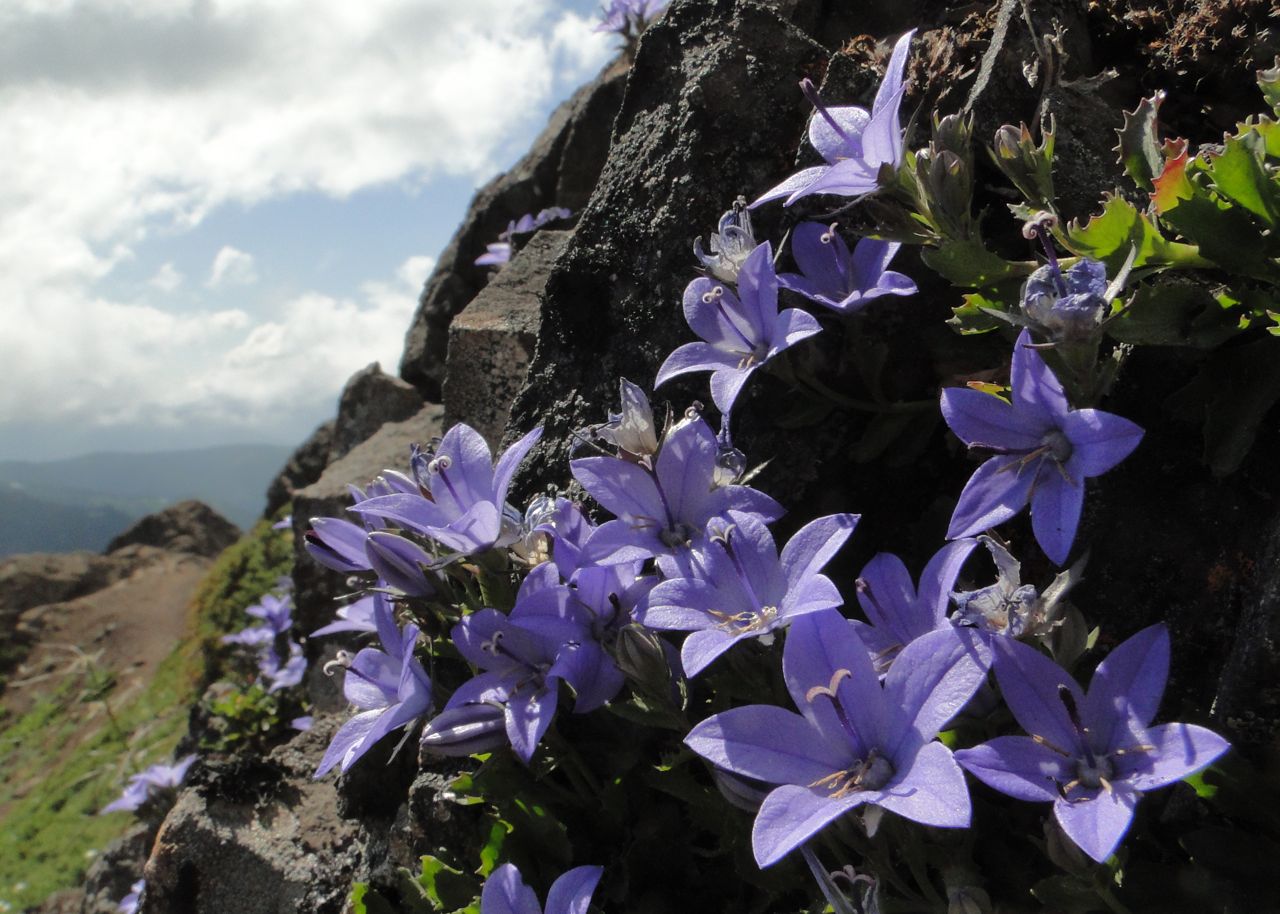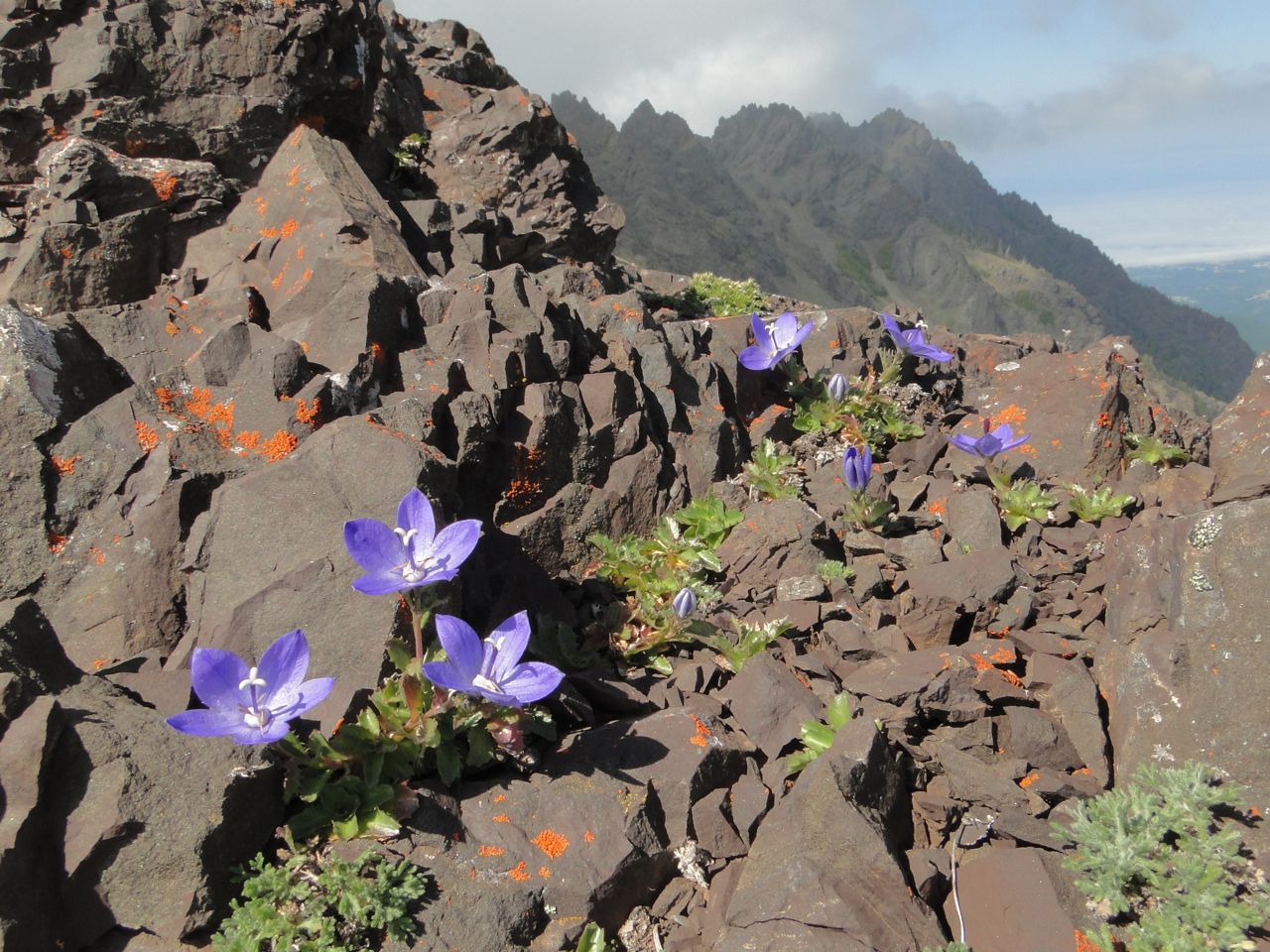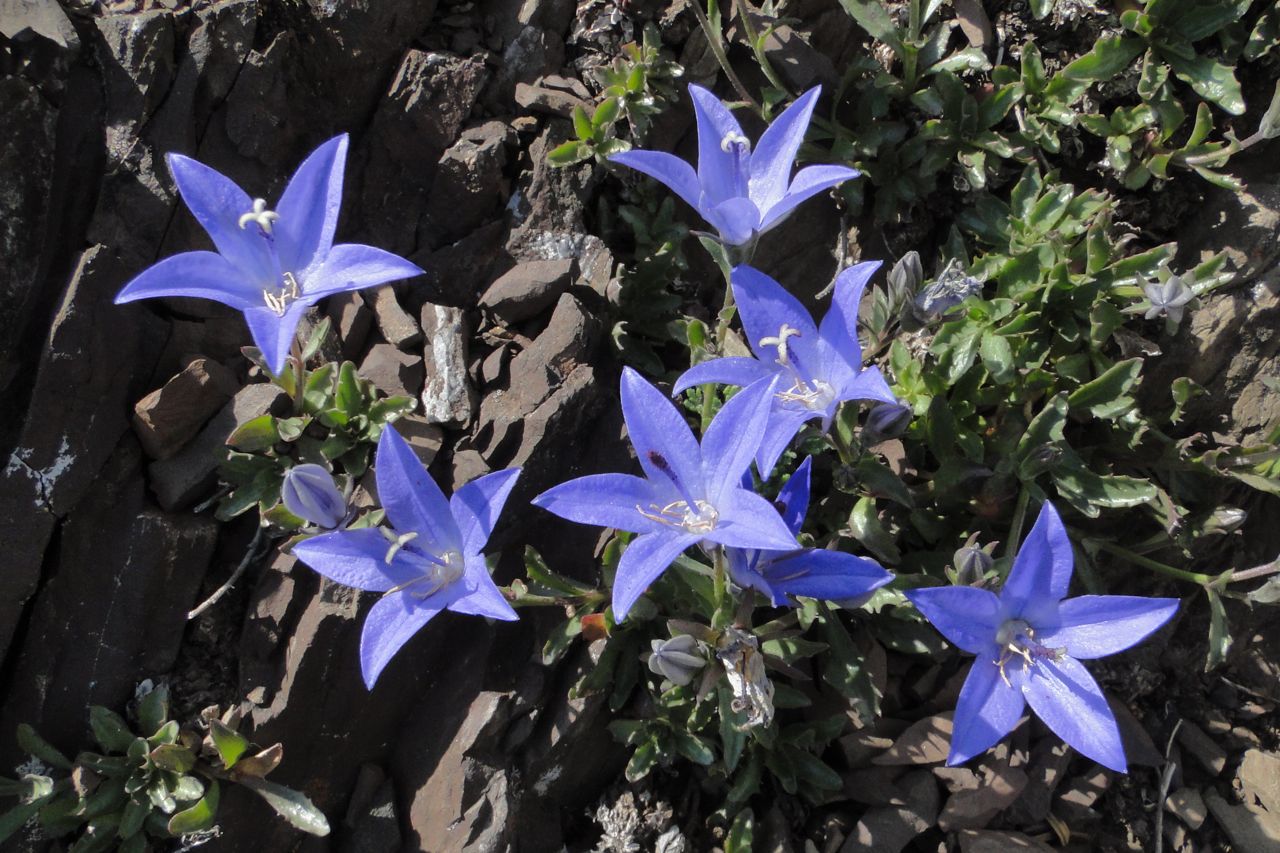Forums:
The snow is finally starting to melt in the alpine areas of the Pacific Northwest and we spent a couple of days in the Olympic Mountains last weekend. The air mass was cool and the mountains in sun above the clouds which resulted in superb light conditions. We went up the Switchback Trail onto Klahhane Ridge and then along the ridge towards Mount Angeles. We found three Olympic endemics on the ridge, Campanula piperi, Viola flettii and Petrophyton hendersonii. The Petrophyton had exquisite foliage quite unlike some plants in cultivation.







Comments
Lori S. (not verified)
Re: Olympic Mountains
Mon, 08/15/2011 - 8:54pmWow, what exquisite plants! That hike looks like a bit of a scramble in that last area! :)
Sellars (not verified)
Re: Olympic Mountains
Mon, 08/15/2011 - 9:05pmThe next day we drove along the road to Obstruction Point to a trailhead. The road passes a cliff with a white Campanula piperi half way up, the only place we have seen this form. The masses of white Erythronium montanum in the meadows right by the road were quite a sight some mixed with rosy purple Castilleja parviflora.
Lori S. (not verified)
Re: Olympic Mountains
Mon, 08/15/2011 - 9:42pmAbsolutely stunning, especially the Erythronium!! 8) 8) Thanks for posting!
Sellars (not verified)
Re: Olympic Mountains
Mon, 08/15/2011 - 9:44pmFrom Obstruction Point we hiked up Elk Mountain. The range of colours in the meadows was astonishing. Outstanding plants included Collomia debilis, Douglasia laevigata, Allium crenulatum, Phlox hendersonii, Potentilla fruticosa, Eriogonum ovalifolium v nivale, Lupinus lepidus v lobbii, Castilleja rupicola and Erigeron compositus above a sea of clouds.
Cliff Booker
Re: Olympic Mountains
Mon, 08/15/2011 - 10:16pmStunning images David! I have just had a cataract operation and these are some of the first photographs I have viewed since the eye patch was removed ... a glorious reawakening for this most precious of my senses. I wish I could fly out and hike that trail within days! Many thanks for your beautiful postings. I eagerly await more.
Toole (not verified)
Re: Olympic Mountains
Mon, 08/15/2011 - 11:00pmWow David !!.
I once flowered Collomia debilis from NARGS seed.Unfortunately it didn't stick around.If memory serves me right all parts of it were very sticky.
Allium crenulatum looks a honey. :)
Thanks for posting.
Cheers Dave.
Anne Spiegel
Re: Olympic Mountains
Tue, 08/16/2011 - 7:32amBeautiful pictures, David. Loved the meadow in bloom, and the collomia (although my favorite is Collomia debilis v larsenii).
Collomia debilis is short-lived here. It does extremely well and then sort of collapses during the late summer mugs.
Having seen where it grows, that's not too surprising. Please, keep the photos coming.
Tim Ingram (not verified)
Re: Olympic Mountains
Tue, 08/16/2011 - 11:48amDavid - why do we live in this little country called Britain with rather beautiful small mountains and hardly any alpine plants!! Your images are exquisite!! The meadow on Elk Mountain would be delightful transposed to our garden. At least I had one flower spike on my Petrophyton hendersonii (one of my favourite plants), but I can only dream about many of the others.
Sellars (not verified)
Re: Olympic Mountains
Tue, 08/16/2011 - 7:52pmAnne and Dave:
I would love to grow Collomia debilis but I suspect it is very difficult as you have experienced. In the mountains we do not often see the plant and it only seems to grow in very loose, steep, shifting scree. How do we replicate that in the garden? The plants on Elk Mountain were all light in colour but I remember the one we saw on Strawberry Mountain, Anne, in 2003 which was deep blue. I have attached a few more pictures and just noticed the lovely sky blue anthers in the close-up.
Sellars (not verified)
Re: Olympic Mountains
Tue, 08/16/2011 - 8:05pmTim:
As it is one of your favourite plants, I have attached a few more images of Petrophyton hendersonii. It was quite difficult to find - only growing on the highest rocky ridges. I grow Petrophyton caespitosum and Petrophyton cinerascens but the Petrophyton hendersonii that I have in the garden is definitely not the right plant having now seen the magnificent foliage of the real thing in the Olympics.
Sellars (not verified)
Re: Olympic Mountains
Tue, 08/16/2011 - 8:15pmA few more images from the Olympics.
Some of the mats of Douglasia laevigata on Elk Mountain were quite large. We also saw Saxifraga caespitosa and Phacelia sericea with Mt Olympus in the distance. At the start of the Switchback Trail there were fine specimens of Pinguicula vulgaris right by the parking lot. Finally a last look at Castilleja parviflora near the Obstruction Point Road.
Cliff Booker
Re: Olympic Mountains
Tue, 08/16/2011 - 10:38pmBeautiful, David ... the Collomia close-up is EXQUISITE!
Trond Hoy
Re: Olympic Mountains
Wed, 08/17/2011 - 12:24amWhat a flora - and what a photographer!
David, if I ever visit this part of the world, is it possible to hire you as a guide? ;)
Anne Spiegel
Re: Olympic Mountains
Wed, 08/17/2011 - 7:08amDavid, I've grown Collomia debilis, which I had seen in the Wallowas, for several years but then it peters out. It likes a scree to ramble through. My plant of choice would be Collomia debilis v larsenii, which I saw in a steep, shifting scree - definitely a soboliferous plant (such a delicious word!). You can duplicate the scree conditions but it certainly doesn't like the humidity of the northeast. Maybe it's just one of thopse plants which refuses to adapt. When I saw it (across from Burroughs Mt. at Mt. Ranier - can' remember the name of the mountain), you could look down the steep scree and see it repeating itself. The roots are anchored in the scree well above the plants. Some of the flowers had hints of an icy blue, others a bit of lavender, quite wonderful. Also love the Allium crenulatum. Have you grown it?
Sellars (not verified)
Re: Olympic Mountains
Wed, 08/17/2011 - 9:06pmAnne:
If I can get some seed of Collomia debilis I will give it a try. I have not grown Allium crenulatum either. I collected some seed of Phacelia sericea last year in our local mountains and now have five vigorous plants growing in pots with lovely silvery foliage. Have you tried it in the garden? I understand it is a challenge.
I like the word soboliferous. I looked it up and it was not clear to me the difference between soboliferous and stoloniferous. Is there a simple explanation of the difference?
Lori S. (not verified)
Re: Olympic Mountains
Wed, 08/17/2011 - 10:30pmFantastic plants and scenes, David!
According to Harris & Harris' Plant Identification Terminology: An Illustrated Glossary (an excellent book, IMO), a sobol is "a shoot arising from the base of a stem or from the rhizome", while a stolon is "an elongate, horizontal stem creeping along the ground and rooting at the nodes or at the tip and giving rise to a new plant". That description, and the illustrations, imply that stolons are above-ground rooting stems (e.g. like on a strawberry plant) while sobols are below ground.
Sellars (not verified)
Re: Olympic Mountains
Thu, 08/18/2011 - 7:21amThanks Lori. That certainly fits how they grow in the wild. They are not a spreading plant but rather pop up randomly in the loose scree.
Stephen Barstow
Re: Olympic Mountains
Mon, 08/22/2011 - 12:43amJust seen these magnificent pictures - amazing that there are such sights in August! What kind of elevations were these pictures taken at? Loved the Erytronium meadow and Allium crenulatum - anyone succeeded growing this one?
Mark McDonough
Re: Olympic Mountains
Mon, 08/22/2011 - 5:12amDavid, glorious plants and photos, it almost seems like one is actually there seeing them in person, the Collomia and Petrophytum views particularly compelling! It is my one biggest regret, in the 4 years that I lived near Seattle Washington, that I never made it out to the Olympics; instead making numerous trips to the dryland central and eastern parts of the State, with my favorite haunt being the Wenatchee Mountains.
Allium crenulatum 'Olympic Sunset'
http://nargs.org/smf/index.php?topic=31.msg181#msg181
Anne Spiegel
Re: Olympic Mountains
Mon, 08/22/2011 - 4:21pm[quote author=David Sellars link=topic=761.msg10889#msg10889 date=1313640405]
Anne:
If I can get some seed of Collomia debilis I will give it a try. I have not grown Allium crenulatum either. I collected some seed of Phacelia sericea last year in our local mountains and now have five vigorous plants growing in pots with lovely silvery foliage. Have you tried it in the garden? I understand it is a challenge. /
It's pretty easy from seed and quick to bloom stage. It seems to want scree but getting it to stick around for more than a couple of years is the difficulty here. I think the summer mugs are not to its liking. Knowing where it grows that's hardly surprising.
Good luck. Should you ever have extra seed of Collomia debilis v larsenii, I'd love to have a little. Every time I've seen the collomia it was growing on a steep scree and that's where I'd try growing it.
Sellars (not verified)
Re: Olympic Mountains
Mon, 08/22/2011 - 8:06pmStephen:
The photos were taken over an elevation range of about 1800 to 2000 m. The deep winter snow cover in the Olympic Mountains takes a long time to melt in some years. This year, 2011 was unusual in the Pacific Northwest with a cold wet spring and cool early summer and the road to Obstruction Point was not free of snow until the first week of August. Some alpine areas in the North Cascades are still snow-covered which is frustrating for hikers in our area.
Stephen Barstow
Re: Olympic Mountains
Tue, 08/23/2011 - 5:59amThanks, David!
I remember being astonished to find the high elevation Lodgepole Pine forest in the Sierra Nevada (California) deep in snow in August one year and I understood this was simply due to the enormous amounts of El-Nino related precipitation that winter. I wonder how the trees cope with this?
Trond Hoy
Re: Olympic Mountains
Wed, 08/24/2011 - 12:50pmIf the soil is not frozen solid under the snow the trees have no problem. They can transport water through their tissue and grow well. I have often seen birches leafing out in deep snow.
DesertZone (not verified)
Re: Olympic Mountains
Sat, 08/27/2011 - 5:47pmAwesome pics, awesome post. 8)
Howey (not verified)
Re: Olympic Mountains
Thu, 09/01/2011 - 4:01amHi David: Have never been to the Olympic Mts. but used to enjoy watching them across the water from Victoria - some days they weren't even there but on other days they were so large and clear you felt you could almost touch them - quite a sight. They, along with the native Dogwood, were frequent subjects for local artists. Our high school sport teams were called Cascades, Selkirks and Olympics - and I was an Olympic. A trip on the ferry (Kalakala or Chinook) to Port Angeles and Lake ? was and probably still is a popular excursion for the folks out there. Fran
Frances Howey
London, Ontario, Canada
Zone 5b
Howey (not verified)
Re: Olympic Mountains
Sun, 09/04/2011 - 4:52amJust remembered the name of the Lake near Port Angeles (Olympic mts.) - Crescent Lake. Sometimes it takes a bit longer to remember things than it used to. Guess Cape Flattery is a fertile spot for botanizing? Fran
Frances Howey
London, Ontario,Canada
Zone 5b
Sellars (not verified)
Re: Olympic Mountains
Sun, 09/04/2011 - 6:35amFran: It's years since we went out to the coast on the Olympic Peninsula. We always head straight up Hurricane Ridge as the road access to the alpine areas is superb and there are lots of hikes in the area. We have also hiked up Mount Townsend at the east end of the range.
On this last trip we had a good view of Victoria and Vancouver Island from the top of Elk Mountain - though not as good as the spectacular view of the Olympics from Victoria!